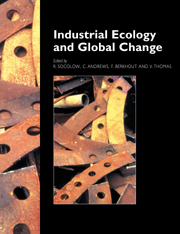Book contents
- Frontmatter
- Contents
- Foreword
- Preface
- Acknowledgments
- Contributors
- OVERVIEW
- PART 1 VULNERABILITY AND ADAPTATION
- 2 Introduction
- 3 Industrial Ecology: Definition and Implementation
- 4 Industrialization as a Historical Phenomenon
- 5 Changing Perceptions of Vulnerability
- 6 The Human Dimension of Vulnerability
- 7 Global Industrialization: A Developing Country Perspective
- PART 2 THE GRAND CYCLES: DISRUPTION AND REPAIR
- PART 3 TOXICS AND THE ENVIRONMENT
- PART 4 INDUSTRIAL ECOLOGY IN FIRMS
- PART 5 INDUSTRIAL ECOLOGY IN POLICY-MAKING
- END PIECE
- Organizing Committee Members
- Working Groups
- Index
3 - Industrial Ecology: Definition and Implementation
Published online by Cambridge University Press: 04 August 2010
- Frontmatter
- Contents
- Foreword
- Preface
- Acknowledgments
- Contributors
- OVERVIEW
- PART 1 VULNERABILITY AND ADAPTATION
- 2 Introduction
- 3 Industrial Ecology: Definition and Implementation
- 4 Industrialization as a Historical Phenomenon
- 5 Changing Perceptions of Vulnerability
- 6 The Human Dimension of Vulnerability
- 7 Global Industrialization: A Developing Country Perspective
- PART 2 THE GRAND CYCLES: DISRUPTION AND REPAIR
- PART 3 TOXICS AND THE ENVIRONMENT
- PART 4 INDUSTRIAL ECOLOGY IN FIRMS
- PART 5 INDUSTRIAL ECOLOGY IN POLICY-MAKING
- END PIECE
- Organizing Committee Members
- Working Groups
- Index
Summary
Abstract
Industrial ecology (IE) is a new ensemble concept in which the interactions between human activities and the environment are systematically analyzed. As applied to industry, IE seeks to optimize the total industrial materials cycle from virgin material to finished product to ultimate disposal of wastes. This chapter provides a discussion of the main ideas of industrial ecology. Industrial impacts on the environment and the means by which industrial processes can be adjusted to lessen these impacts through waste minimization and recycling are also discussed.
Introduction
Industrial ecology (IE) is a new ensemble concept, although some of its individual elements have been recognized for some years. IE arises from the perception that human economic activity is causing unacceptable changes in basic environmental support systems. As applied to manufacturing, this systems-oriented concept suggests that industrial design and manufacturing processes are not performed in isolation from their surroundings, but rather are influenced by them and, in turn, influence them.
In industrial ecology, economic systems are viewed not in isolation from their surrounding systems, but in concert with them. That is, it is the study of all interactions between industrial systems and the environment. As applied to industrial operations, it requires a systems view in which one seeks to optimize the total industrial materials cycle from virgin material to finished material to component to product to waste product and to ultimate disposal. Factors to be optimized include resources, energy, and capital.
- Type
- Chapter
- Information
- Industrial Ecology and Global Change , pp. 23 - 42Publisher: Cambridge University PressPrint publication year: 1994
- 46
- Cited by

